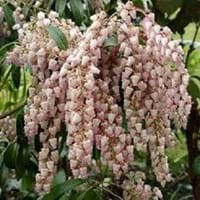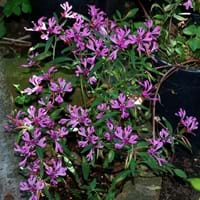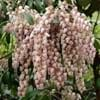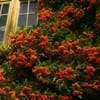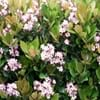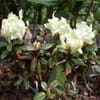Life Span
Perennial
Annual
Type
Broadleaf Evergreen
Flowering Plants
Origin
Eastern Asia
United States, California
Types
Mountain Fire , Variegata , Purity , Red Mill
Santa Clara red ribbons, red ribbons, Raiche's red ribbons
Habitat
Lowland evergreen rainforest, Shaded sites
Dry areas, foothill woods
USDA Hardiness Zone
5-9
Not Available
AHS Heat Zone
Not Available
9 - 1
Sunset Zone
21,22
A3, 1a, 1b, 2a, 2b, 3a, 3b, 4, 5, 6, 7, 8, 9, 10, 11, 12, 13, 14, 15, 16, 17, 18, 19, 20, 21, 22, 23, 24
Habit
Upright/Erect
Clump-Forming
Flower Color
White, Red, Light Pink, Hot Pink
Pink, Fuchsia, Rose, Lavender
Flower Color Modifier
Bicolor
Bicolor
Fruit Color
Tan
Not Available
Leaf Color in Spring
Red, Green, Dark Green, Pink, Bronze
Green, Gray Green
Leaf Color in Summer
Green, Dark Green
Green, Gray Green
Leaf Color in Fall
Green, Dark Green
Green, Gray Green
Leaf Color in Winter
Green, Dark Green
Light Green
Leaf Shape
Lanceolate to elliptical
Ovate
Plant Season
Spring, Summer, Fall, Winter
Spring, Summer
Sunlight
Full Sun, Partial Sun, Partial shade
Partial Sun, Partial shade
Type of Soil
Loam
Loam, Sand
The pH of Soil
Acidic
Neutral
Soil Drainage
Well drained
Well drained
Bloom Time
Early Spring, Late Winter
Spring, Late Spring, Early Summer, Summer
Tolerances
Deer resistant, Light Frost
Not Available
Where to Plant?
Ground
Container, Ground, Pot
How to Plant?
stem tip cuttings
Seedlings, Stem Planting
Plant Maintenance
Medium
Medium
Watering Requirements
Keep the Soil well drained, Requires consistently moist soil
Allow to dry out slightly between watering
In Summer
Lots of watering
Lots of watering
In Spring
Moderate
Moderate
In Winter
Average Water
Average Water
Soil Type
Loam
Loam, Sand
Soil Drainage Capacity
Well drained
Well drained
Sun Exposure
Full Sun, Partial Sun, Partial shade
Part sun, Partial shade
Pruning
Prune after flowering, Remove damaged leaves, Remove dead branches, Remove dead leaves
Remove damaged leaves, Remove dead branches, Remove dead leaves
Fertilizers
All-Purpose Liquid Fertilizer, fertilize in spring, fertilize in winter
All-Purpose Liquid Fertilizer
Pests and Diseases
dieback, Leaf spot, Mites, Soft scales
Red blotch
Plant Tolerance
Deer resistant, Light Frost
Drought
Flower Petal Number
Single
Single
Showy Foliage
Yes
Not Available
Foliage Texture
Medium
Fine
Foliage Sheen
Glossy
Matte
Attracts
Birds, Butterflies, Hummingbirds, Moths
Butterflies
Allergy
Not Available
Not Available
Aesthetic Uses
Beautification, Cottage Garden, Ornamental use, Showy Purposes, Wild gardens
Showy Purposes
Beauty Benefits
Not Available
Not Available
Environmental Uses
Air purification
Air purification
Medicinal Uses
No Medicinal Use
Not Available
Part of Plant Used
Not Applicable
Not Available
Other Uses
Not Available
Used as Ornamental plant, Used for its medicinal properties
Used As Indoor Plant
No
No
Used As Outdoor Plant
Yes
Yes
Garden Design
Feature Plant, Foundation, Hedges, Mixed Border, Screening, Wind Break, Topiary, Bonsai, Espalier
Bedding Plant, Showy Tree
Botanical Name
PIERIS japonica
CLARKIA concinna
Common Name
Japanese Andromeda
Red Ribbons
In Hindi
Japanese pieris
Clarkia concinna
In German
Japanese pieris
Clarkia concinna
In French
Japanese pieris
Clarkia concinna
In Spanish
Japanese pieris
concinna clarkia
In Greek
Japanese pieris
Clarkia concinna
In Portuguese
Japanese pieris
Clarkia concinna
In Polish
Japanese pieris
klarkia concinna
In Latin
Japanese pieris
Clarkia concinna
Phylum
Magnoliophyta
Tracheophyta
Class
Magnoliopsida
Magnoliopsida
Family
Ericaceae
Onagraceae
Clade
Angiosperms, Asterids, Eudicots
Angiosperms, Eudicots, Rosids
Tribe
Lyonieae
Not Available
Subfamily
Vaccinioideae
Not Available
Number of Species
Not Available
Not Available
Season and Care of Japanese Pieris and Clarkia concinna
Season and care of Japanese Pieris and Clarkia concinna is important to know. While considering everything about Japanese Pieris and Clarkia concinna Care, growing season is an essential factor. Japanese Pieris season is Spring, Summer, Fall and Winter and Clarkia concinna season is Spring, Summer, Fall and Winter. The type of soil for Japanese Pieris is Loam and for Clarkia concinna is Loam, Sand while the PH of soil for Japanese Pieris is Acidic and for Clarkia concinna is Neutral.
Japanese Pieris and Clarkia concinna Physical Information
Japanese Pieris and Clarkia concinna physical information is very important for comparison. Japanese Pieris height is 30.00 cm and width 30.00 cm whereas Clarkia concinna height is 25.40 cm and width 25.40 cm. The color specification of Japanese Pieris and Clarkia concinna are as follows:
Japanese Pieris flower color: White, Red, Light Pink and Hot Pink
Japanese Pieris leaf color: Red, Green, Dark Green, Pink and Bronze
Clarkia concinna flower color: Pink, Fuchsia, Rose and Lavender
- Clarkia concinna leaf color: Green and Gray Green
Care of Japanese Pieris and Clarkia concinna
Care of Japanese Pieris and Clarkia concinna include pruning, fertilizers, watering etc. Japanese Pieris pruning is done Prune after flowering, Remove damaged leaves, Remove dead branches and Remove dead leaves and Clarkia concinna pruning is done Remove damaged leaves, Remove dead branches and Remove dead leaves. In summer Japanese Pieris needs Lots of watering and in winter, it needs Average Water. Whereas, in summer Clarkia concinna needs Lots of watering and in winter, it needs Average Water.
